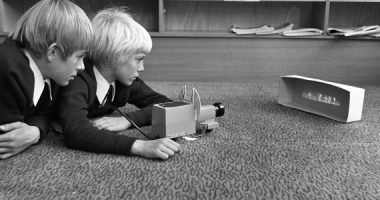
A large group of female war workers queue to clock in for work at a gun factory. Great Britain, 1940. © IWM (D 672)
Some concepts linked to the digital society have already become embedded in our culture, although their meaning is sometimes vague. They include notions such as “the acceleration of time”, “real time” communication, “multitasking”, and “globalised time”, which attempt to describe the situations that we are faced with in the new digital ecosystem. To counteract this (biased) account of the pace imposed by digital technologies, a few critical voices are questioning our responsibility when it comes to the way we understand, create, and socially use this new digital time. On 22 February, Judy Wajcman will talk about time in the digital age at the CCCB.
The question of the nature of time is one of the oldest debates there is. Some people believe that time is a thing that exists in measurable form, while others think it is alive, and that we are made of time. This debate is gaining new momentum in the digital society, now that the Internet, mobile devices, and other digital artefacts offer us new ways to experience and understand time.
New Timescapes
Imagine it is an ordinary weekday. You leave work mid-afternoon and walk to the bustop, chatting on your mobile with a friend that you’ve arranged to meet. You check the time on your watch and mentally count the number of stops to work out how late you’re going to be. But you decide to double-check and open an app that calculates it for you with a processor running at 4 billion cycles per second. Near the crossing, you estimate how fast the cars are travelling on the next street, and try to guess whether you will get a green light. You look at the phone and see that your friend sent a message 3 minutes and 2 seconds ago to ask how long you will be. You start running because you know she hates waiting.
You get to the bus stop. You watch the clouds drift by, listen to the pealing of the cathedral bells, and notice the speed of your heartbeat. You look at the old man walking slowly along the footpath opposite, and at the girl on the seat beside you, immersed in a science fiction novel set in a distant future. The information panel at the bus stop informs you that your bus is due in 3 minutes and 10 seconds. You are 17 minutes and 3 seconds away from your rendezvous, 6 hours and 18 seconds from bedtime, and you have 7 hours and 23 seconds of battery left. The girl beside you is still immersed in fictional time. You get on the bus.
Living in society means constantly interacting with various indicators of time and different time scales, which mix with our own individual experience, memory, intuition, and ever-changing sense of the passing of time, on which we base our present and future plans. In her 2004 book Time, Barbara Adam, a leading theorist of contemporary approaches to the study of time, used the term “timescapes” to describe the complex mix of different biological and mechanical rhythms, with different speeds and tempos, in which we live. These timescapes now coexist with the rhythms and times of the digital ecosystem that runs parallel to the “real” world, sometimes in harmony, sometimes in confrontation. Time becomes more “present” to us, it flows, expanding and contracting, behaving in the way French philosopher Henri Bergson theorised the time: as a continuous flow that has a duration, and constantly moves from the present to the past. According to Bergson, time is not an indivisible whole and cannot be reduced to quantifiable discreet units. Instead, it is an internal, subjective state that often clashes with its technical representations: digital time is reproducible, reversible, and infinite, while human time is irreversible, limited, and subjective.

License: CC0. Source: negativespace.co
Technological advances have always affected the relationship between space and time in society, particularly during the industrial revolution. There is nothing new about this, but our everyday timescapes appear to be accelerating exponentially. This is due to digital technology, which plays a key role because our experience of time is increasingly mediated by digital devices of all kinds. And this mediation is neither minor nor neutral, especially as these devices function at different rhythms and synchronies, and are constantly evolving.
Our perception and use of time in digital communication depends on interfaces and software, and their ability to transmit data. The calculation speed and acceleration underlying the algorithms that we use to organise and display data limit the information we have access to, and thus our understanding of our world. In spite of their importance, we scarcely question them, partly because we lack time due of their rapid obsolescence, the rhythm they force on us, and the time we have to spend on learning to use and maintain them.
Network Time
In recent years, the Internet has become an arena where of these new temporalities come together: a digital convergence of most earlier media, along with the new time conflicts that are native to the net itself. In The Rise of the Network Society (1996), professor Manuel Castells used the concept of “timeless time” to reflect on what he saw as the waning of biological and social time in favour of homogenous, globalised time in network societies. Castells argued that temporality is transformed in the information network age, in which our experiences of time dissolve into a timeless cyberspace. Similarly, in Open Sky (1997), Paul Virilio noted that in the physical world the “when” is linked to the “where”, and suggested that we are losing our time reference because instant communication and network time are “killing” the present, separating it from its place and context, so that the concrete presence of the communicative act is no longer important.
Meanwhile, in 24/7 Time and Temporality in Network Society (2007), Robert Hassan argues that these earlier interpretations of a network society in which capitalism has imposed a global market and a global temporality fail to account for the acceleration of flexible time, in a world where networks modulate and converge in a very wide range of social experiences of time. Hassan believes that the true temporality of networks is asynchrony, because the huge ecosystem of the Internet allows each user to engage with different spaces and times independently of their “real” local time. Homogenous, globalised linear time becomes an almost infinite fragmentation of different synchronous and asynchronous time contexts that are alive on the net.

License: CC0. Source: kaboompics.com
The network society radically alters our relationship to clock-time, to local and global social time. It does not replace or reject it. It displaces it, offering new ways of controlling and experiencing time. Hassan uses social media and chat rooms as an example: there is no relationship between these communication spaces and the actual local time of the users. This is a huge challenge, given that all spaces are time contingents that shape our experience. There are timetables and schedules at the workplace for example, some determined by the nature of the work, and some by cultural dynamics. In this sense, the Internet can be seen as an opportunity to change the “rules” that govern and control social time, and to reinvent new spaces and contexts for communication.
The Boundaries Between Work and Leisure
The boundary between work and leisure is increasingly blurred. The information and communication networks and mobile devices that are part of our everyday lives can become a means by which work expands into our leisure time. For this reason, countries like Francehave decided to regulate the use of e-mail outside of working hours, and German companies such as Volkswagen are restricting employee access to email accounts outside of work. Digital communication tools have changed the world of work so drastically that its boundaries have become unclear, not just in terms of working hours but also in terms of physical presence, given that there is often no longer a single, stable workplace. This change is not just quantitative, and it does not just affect work efficiency or performance (always called into question in Spain). Above all, it affects the way work is organised, and the role of the employee in this new stage. The fifteen-hour working week that the economist John M. Keynes predicted in 1930 for his grandchildren’s generation as a result of production efficiency and technological progress echoes in the background whenever we check our e-mail outside of work.
In her recent book Pressed for Time (2015), sociologist Judy Wajcman draws attention to the need to organise ourselves in order to deal with the sense of always being overwhelmed by work (by work time). We seem to transmit a positive image when we complain about how much time it takes to manage work e-mails, Wajcman says, perhaps because it suggests a big workload, but also because it indicates that we have the skills required to use digital technology for work management.

License: CC0. Source: photos.oliur.com
But technology was supposedly created to help us do our work more efficiently and productively (or so we’ve been told), so shouldn’t the fact that we feel trapped by work through digital devices be considered a collective failure to manage work and said devices, rather than as a merit? The more time-pressed we are, the more we consume digital devices, as if they were a drug.
Another interesting issue that Wajcman points out is the tendency to individualise our experience of time. Monitoring our personal activities through apps and i-Watches, to “manage” our lives and make us more “efficient” makes us see time as a personal measure, as if it were a quantifiable material. Nothing could be further from the truth, given that time comes from and is used in the communal construction of activities in society.
Digital technologies are a further step in the history of the acceleration of production processes, but for the time being they have not freed us from work or decreased our work time. The planning and design of digital environments and devices to increase work efficiency should not be the only way to understand and conceptualise the temporalities these new digital scenarios. Which is why, as Wajcman says, we need to realise that the imperative of speed is just one of the possible cultural artefacts we have constructed to help us understand this new digital world. And it is up to us to resist the prevailing narrative by exploring, understanding, and developing cultural alternatives to the temporal experiences of our digital ecosystem.





Leave a comment